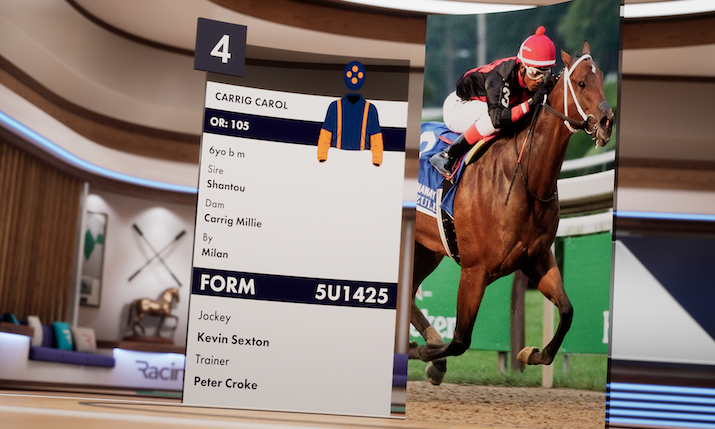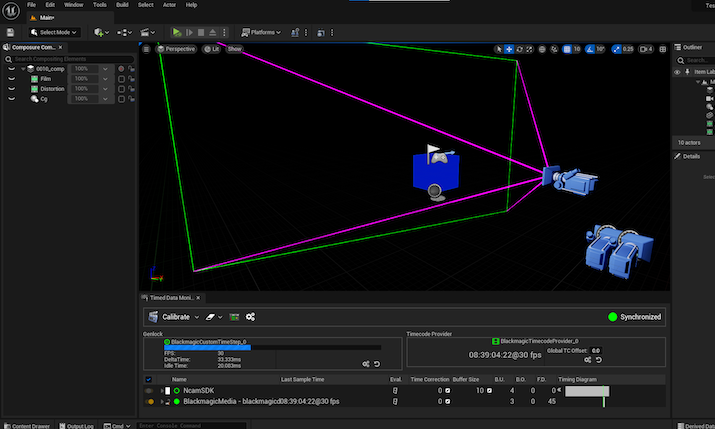Tech focus: Striking a balance with broadcast graphics

Moov recently created Racing TV’s first AR graphics package
Deltacast, Moov, Ncam Technologies and Singular.live discuss advances in graphics for sports broadcasts and explore the need to inform and engage viewers without overwhelming them.
Anyone who’s watched sport in recent years will have noticed the change in how graphics are used to enhance and inform the viewing experience. While just a few years ago AR graphics were a nice to have, now they’re an expected feature of many sports broadcasts and more enhancements are in the pipeline. The future for graphics undoubtedly looks rosy, but it’s not without its challenges, most notably how to deliver the right information to engage the viewer and add to the story without overwhelming and distracting fans from the action.
“Graphics have been used to enhance story-telling for decades now,” says Mike Ward at Singular.live. “At the same time, a greater volume of data is more readily available and presenting this in an easily digestible format is essential for viewer engagement and enjoyment. However different viewers have different tastes with some wanting more data, others wanting less. The ability to use modern graphics platforms to deliver interactive and personalised graphics with client-side or on device rendering enables this.”
Niki Whittle, business strategy executive at Moov, agrees, adding: “Storytelling should be at the heart of all things visual; it goes back to the saying content is king and we need that content to sing. It’s about creating a balance from the visual to expectations of what’s needed; if the graphics are taking the attention away from the actual state of play, the audience will just become frustrated. Save the wow factor graphics to build the suspense and excitement for the game or to maintain the atmosphere during half time, but throughout actual gameplay let the action be the main focus and use the graphics as a visual aid to quietly complement the storytelling by providing essential information and context to the audience.”
Her advice: “Talking with key stakeholders and the fans from the outset is key to creating something truly engaging, which in turn will create a lasting message in how the story unfolds.”
“Save the wow factor graphics to build the suspense and excitement for the game or to maintain the atmosphere during half time, but throughout actual gameplay let the action be the main focus”
The increase in available data has also had a huge impact on the quality of graphics available, helping the viewer to understand the implications of actions on the field and keeping them engaged.

Nikki Whittle, Moov
Whittle adds: “Data-driven graphics are essential to build the story and bring the audience into the narrative to keep them invested in the outcome of a match. Throughout a game, there is a huge amount of data that is being collected but graphics can be used to condense this down into visually appealing key information that empowers viewers with information, so they can make informed judgement and engage in discussions about the game, which further enhances their involvement.”
“Data-driven graphics fast-track viewers to a better understanding of the game,” says Andy Newham, sales director EMEA at Ncam Technologies. “I think we are also now evolving as sports viewers and consumers to be able to take on much more information simultaneously. The new generation is able to multi-task entertainment across multiple devices to a point where not only are they able to cope with multiple sources of information, but they are even demanding it from the broadcasters they are tuning into. If the information is not there on the first screen they will quickly turn to second and third screens to find it.”
This is leading to added pressure on broadcasters to deliver more content to more screens than ever before.
“The main thing we are hearing from broadcasters when they are looking at Singular is they need a way to allow them to create more content across more platforms while also increasing flexibility, scalability and reducing cost,” confirms Ward. “As they are delivering their content to more channels, they are seeking solutions like Singular that can replicate their current on-air graphics without the requirement for additional graphics hardware.
“As more productions are trying to maximise the value of their content, distributing it in more formats to a wider array of destinations, the importance of scalability becomes significant. This is even more so with the growth of FAST channels and multi-format outputs. Delivering all of those using traditional solutions becomes prohibitively expensive very quickly.”
Continuing the AR transformation
While AR technology has been around for some time, the feeling is that it still has the potential to transform the market further.

Gérald Olivier, Deltacast
“Since 2021, augmented reality has disappeared from the Gartner Hype Cycle, meaning that it is no longer considered an emerging technology and is now ready to move from pilot to productivity,” explains Gérald Olivier, head of product marketing, Deltacast. “We typically observe this in the sports broadcast industry. Those AR technologies have not only become accepted parts of sport broadcasting, they have become staples in the broadcasting of their specific sport. At Deltacast we firmly believe that AR-enhanced broadcasts have the potential to change the future of sports broadcasting. Their acceptance will be due in large part to consistent exposure.”
There is, however, a clear challenge for broadcasters when it comes to getting the balance right, as Olivier explains. “In our daily discussions with TV production teams, they all highlight the fact that finding the right balance between augmented reality and readability of the game is critical. This may indicate that AR-enhancements should be incorporated into broadcasts gradually in order for viewers to gain a familiarity with the graphics.”
This isn’t the only challenge being faced. Ward returns to the issue of finances: “The main challenges I would say these days are around cost and resources. You can pretty much do whatever you want graphics-wise now, but whether you can do it within budget is another matter. There is also a well-documented skills shortage in broadcast, which pushes up the cost of good operators and artists who are in high demand.”
Team work
Whittle adds: “It’s the whole production puzzle piece, how do you innovate, scale up and push creative boundaries without disrupting the current workflows or distracting from the production pipeline, in a cost-effective way? Sports broadcasts involve multiple stakeholders, including broadcasters, production teams and graphics operators. Not only do live graphics need to look amazing but they also need to be easy to control and manage.
For Moov, how we overcome this, is that we ensure that our teams fully understand the full end-to-end production workflow and all our playout control interfaces are built with interoperability and scalability in mind, to seamlessly integrate and work across a variety of engines while remaining operator friendly. As we innovate, we always think about the production pipeline and where that frees up the technical and operational complexities so production teams can purely focus on the editorial content.”

NCam’s AR Suite supports professional virtual graphics and in-camera VFX
Olivier agrees that a team-focused approach is key to success when it comes to telling the story of sport. “It’s a team effort between the editorial team, the tech provider and the production team. The production team has creative ideas, the editorial team knows which stories to tell, and the tech provider can offer the best solution to match the requirements.
If you start with the technology, then you risk bringing distraction rather than complementing the storytelling.”
So what can viewers expect to see when it comes to graphics in the coming years?

Mike Ward, Singular.live
“The big developments I believe will be driven by cost,” says Ward. “So an increasing uptake in cloud-based services that can help reduce cost and the environmental impact of live production. Broadcasters will move from a position of having to have the latest and greatest on-air productions to having ‘good enough’ productions as they look to save money. They will look to retain hardware for longer wherever possible extending the lifespan of their kit. I also think there will be continued consolidation in our industry as PE and VC owners look to either cut their losses or buy their way out of declining revenues. Finally, based on what we are seeing, there will be further adoption of HTML and cloud-native graphics because the projects we have lined up are increasingly with mainstream broadcasters.”
“We expect to see more developments around immersive experiences and how to further enhance fan engagement by converging the use of traditional broadcast graphics, AR and virtual,” says Whittle. “Advancements in real-time rendering and virtual production techniques will contribute to more realistic and customisable virtual studio experiences and there are still questions about how will the metaverse and digital twins be used to allow fans to interact with their favourite teams and athletes in new ways. For sports, it will always be about where to find the best uses of these new developments without taking away from the essence of the game itself.”

